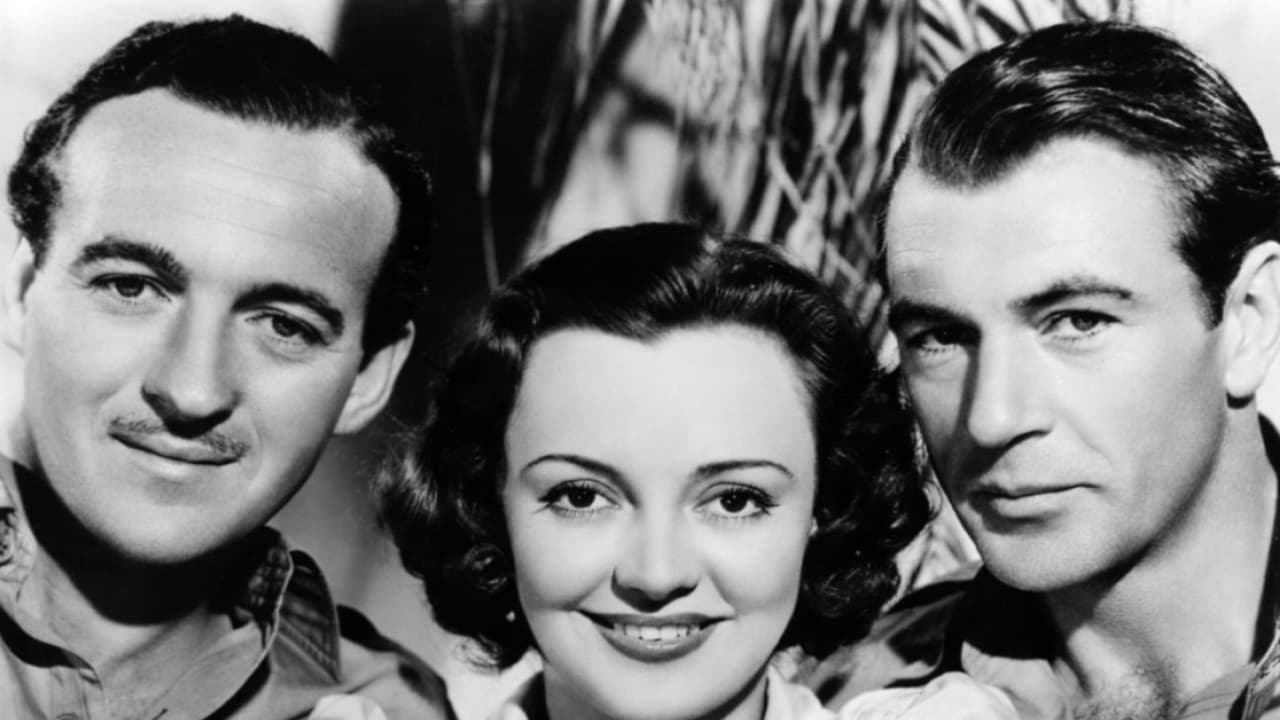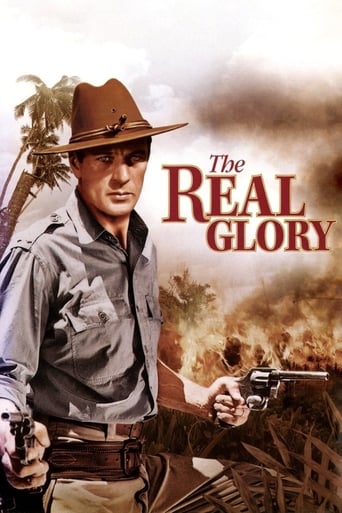

I had no idea what to expect from THE REAL GLORY, a 1930s adventure film set in the Philippines but shot in California. It stars Gary Cooper in a role long before HIGH NOON, and he plays one of many officers stationed in the Philippines and attempting to stifle an uprising by Muslim rebels. The film is directed by Hollywood director Henry Hathaway, who directed a lot of good stuff over a long career including John Wayne's TRUE GRIT. The tale starts off a little slow but it turns out that it's merely taking time to get to know the characters before involving them in an action-packed tale. Indeed, THE REAL GLORY gets better and better as it goes on, turning into a pulp story full of outlandish incident and heroism.Things culminate in an incredible siege climax which is one of the best-directed I've seen from the era. It's edge of the seat stuff, full of violence, stunts, and general excitement, ending the movie on a real high. Cooper is a solid and likable lead and given fine support from the likes of a youthful David Niven and Broderick Crawford. Even Andrea Leeds isn't out of place as the token female. Watch out for Japanese actor Tetsu Komai who made a career of playing villainous Oriental types in the 1930s.
... View MoreTHE REAL GLORY 1939This Samuel Goldwyn Production is about a series of battles during the Moro war in the Philippines. This armed conflict took place from 1903 to 1913. The film stars, Gary Cooper, David Niven, Broderick Crawford, Andrea Leeds, Reginald Owen, Russell Hicks and Vladimir Sokoloff.The film is set on the Philippines island of Mindanao. The US Army is pulling out and leaving the local militia and Police force in charge. The locals are sure that once the US Army leaves, the Moro guerrillas will swoop in and kill all the men, then sell the women and children into slavery. The Army leaves several men to help train the locals to defend themselves. (Cooper, Niven, Crawford, Owen, Hicks) The Moro leader, Tetsu Komai, tries to draw the American led militia out into the jungle where they plan on slaughtering them. When this does not work, Komai, with help from his inside man, Vladimir Sokoloff, send in several suicide types to kill the American commanding officer. This they succeed in doing, but this also fails to bring out the Constabulary. Now the Moro types dam up the river and stop the flow of fresh water to the village. There is soon a cholera problem and people start to die. The Army doctor, Gary Cooper does what he can. The man in charge now, Reginald Owen, is afraid to do anything about the problem. He is going blind from an old wound. Needless to say he is keeping this info from Cooper and the rest. Owen finally orders one of the men, Broderick Crawford, to take a detachment of militia and destroy the dam. The problem here is that the Moro leader is kept up to date on the intelligence front by inside man, Sokoloff. Broderick and his men are massacred with only a single survivor. The situation now is desperate in the village from lack of fresh water, as well as the disease problem.Now Sokoloff steps up and offers to lead another detachment up a secret trail to the dam. Owen falls for the ploy and leads off most of the militia garrison. They also take along a healthy amount of dynamite. Cooper, left in command of the village, now discover Sokoloff's duplicity. He puts David Niven in charge, grabs up a shotgun and takes off to warn Owen.While Owen is being led up and down various jungle paths, the Moros have massed for an attack on the now depleted garrison. Cooper manages to reach Owen and fill him in on Sokoloff. After disposing of the swine Sokoloff, Cooper and the rest destroy the dam, build some rafts, and return to the village. Meanwhile, back at the ranch, er, I mean the village, there is a full-fledged battle going on. The Moros, using freshly captured rifles, are getting the upper hand. Inside the barricades, Niven and the remaining militia are putting up a stubborn bit of resistance, but they are outnumbered and losing ground. Just as it looks like the Moro bunch will be victorious, Cooper and the boys arrive. They take the Moros in the flank and soon have them on the run with heavy casualties. The Moro leader, Komai, is killed by one of the Philippine Militia officers, Rudy Robles. The threat to the village and its people is ended. There is a side plot where Reginald Owen's daughter, Andrea Leeds, falls for the dashing doctor, Cooper. This one comes off like a version of Gunga Din with plenty of action and derring do. The director was Henry Hathaway, who had worked with Cooper on, THE LIVES OF A BENGAL LANCER. Hathaway cranked out more than a few decent films during his career. These include, SOULS AT SEA, SPAWN OF THE NORTH, WING AND PRAYER, THE BLACK ROSE, RAWHIDE, KISS OF DEATH, NIAGARA, THE SONS OF KATIE ELDER and TRUE GRIT. Helping out behind the camera was Rudolph Mate. The 5 time Oscar nominated cinematographer (Gilda, Sahara) would become a director himself. He would crank out a series of well-respected westerns and film noir like, DOA, UNION STATION, BRANDED, THE VIOLENT MEN, SIEGE AT RED RIVER, THE FAR HORIZONS, and THE RAWHIDE YEARS.
... View MoreThe USA didn't have much of a foreign colonialist period. Like Germany, we came rather late to the game. Besides which Americans were busy colonizing their own interior.But in the mid- to late 1930s stories of colonial adventures abroad seemed to become suddenly popular in Hollywood, or at least simplified and romanticized versions of same. Gary Cooper was in a surprising number of them. Usually they're a lot of nonsensical fun. Discounting American Westerns, there were "Gunga Din," "Lives of a Bengal Lancer," "Beau Geste," "Morroco," "The Charge of the Light Brigade," others whose names escape me, and this one, "The Real Glory." It takes place in the land of the Moros (Filipino Moslems) who resent the Westernization of their cobbled-together country by first Spain, then, after the Spanish-American war, the Americans. That war is still being fought. But, not to worry, everything in the movie turns out alright in the end -- well, almost.Gary Cooper, David Niven, and Broderick Crawford are Army lieutenants stationed at an undermanned fort surrounded by jungle and enemies. If you think of this as a rather typical situation for this sort of action movie, you're probably on the right track. It usually leads to a heroic defense of the fort by our side. And it gives the writers a chance to have hordes of evildoers charging the fort to be mowed down in rows like wheat by a motorized reaper. There must be at least one heroic sacrifice too, of a secondary character. Sometimes there's just one (Gunga Din) and sometimes, as here, both Niven and Crawford are given a chance to make the supreme sacrifice. Of the two sacrifices, Crawford's is the more supreme. A harmless, doltish officer who is devoted to growing orchids, he is captured by the Moros, his head smeared with honey, and then he is buried up to his neck in an ant hill. Those Moros were pitiless cookies. If I'm not mistaken the Colt Model 1911 .45 caliber automatic, a veritable cannon at the time, was developed partly because smaller caliber pistols were thought unable to stop a charging Moro.The rafting scenes were done, it appears, in the lower reaches of the Kern River. This is a dangerous area to raft or inner-tube in. It's the only rushing water for ten thousand miles around Bakersfield, California, and is a popular bathing spot in the summer, even though a few rafters and tubers usually are lost. It's interesting too in that it is the only known home of the Kern Valley salamander (Batrachoseps simatus), and only for a stretch of a few miles along the bank -- and only the northern bank.I think I like Gunga Din better because there is more slapstick, more laughs all around, and because the characters are a little better developed. But "The Real Glory" is nothing to be ashamed of. An enjoyable romp by stars wearing colorful uniforms in an exotic location and involved in a conflict nobody ever heard of.
... View MoreWhat appears to be an imperialist jungle army adventure along the lines of Gary Cooper's previous 'Lives of a Bengal Lancer' turns out to be a disaster movie. Like all disaster movies, we sit through an hour and a half of character japery, sinister plots and love interests before the climactic spectacular set-piece, an old-fashioned dam-busting that spurts a Wagnerian birth-rush, waking up the cholera-ridden locals. One could carp at the era's ideology - the well-rounded Americans; the infantilised Filipino locals; the sinister Fu Manchu villains. What are more interesting are the cracks - the violent vengefulness that grips David Niven's previously amiable character; the shocking murder of the commander in front of his wife and impotent peers; the blind intransigence of his replacement, Captain Hartley.
... View More